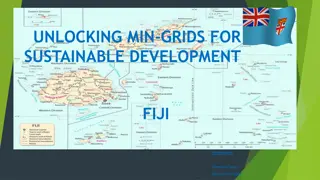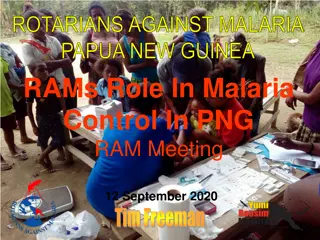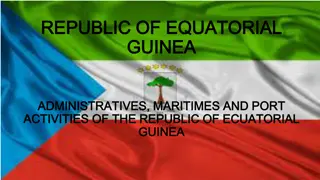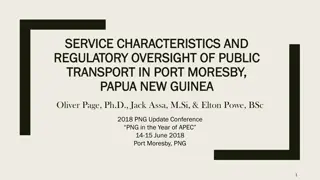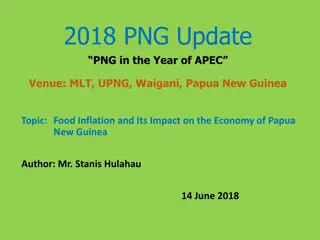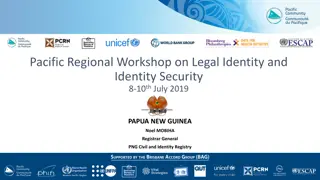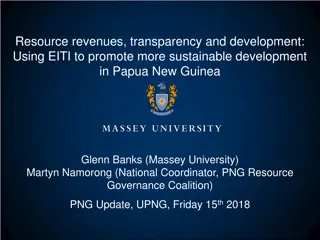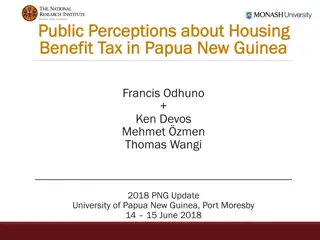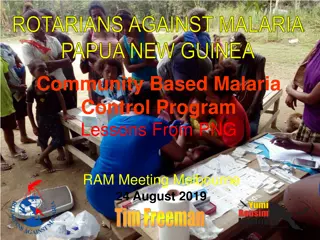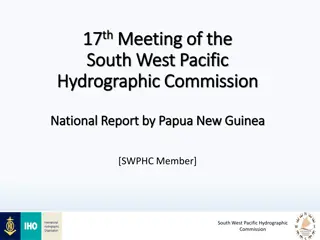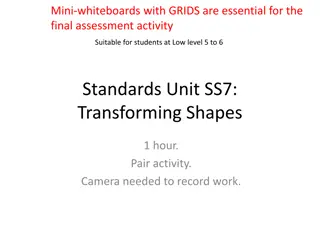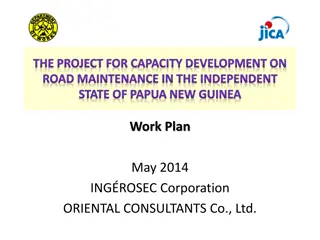Unlocking Mini Grids for Sustainable Development in Papua New Guinea: Business Models & Challenges
Papua New Guinea has ambitious targets for electricity access, electrification, and climate action. The government aims to achieve universal electricity access by 2050, with specific goals to increase access rates and renewable energy penetration. Initiatives like the Rural Electrification Program focus on providing electricity to rural areas using sustainable sources. PNG is committed to reducing greenhouse gas emissions, aligning with international agreements like the Paris Agreement and setting its own targets for climate action. The country's efforts reflect a transition towards a low-carbon future while ensuring reliable energy access for all.
Download Presentation

Please find below an Image/Link to download the presentation.
The content on the website is provided AS IS for your information and personal use only. It may not be sold, licensed, or shared on other websites without obtaining consent from the author. Download presentation by click this link. If you encounter any issues during the download, it is possible that the publisher has removed the file from their server.
E N D
Presentation Transcript
tta Unlocking MG for sustainable development: Mini Grids Business Models, Papua New Guinea Suva, Fiji June 26th-30th, 2023 Presented by Samuel Petau Manager, Monitoring & Evaluation PNG National Energy Authority www.tta.com.es The information contained in these documents is confidential, privileged and only for the information of the intended recipient and may not be used, published or redistributed
PRESENTATION OUTLINE PRESENTATION OUTLINE 1: What are the current electricity access and electrification and climate targets in Papua New Guinea? 2. Role of mini grids in Papua New Guinea 3. Current mini-grids systems [sites, capacity & technologies] on the ground and planned systems in Papua New Guinea 4. Management / institutional structure for rural electrification and mini-grids 5. Business models / tariff settings for mini-grids 6. Experiences and challenges with mini-grids systems in Papua New Guinea 7. Lessons Learnt
1: What are the current electricity access and electrification and climate targets in Papua New Guinea?
Papua New Guinea has set the following electricity access and electrification targets: i. Papua New Guinea's National Energy Policy (2018-2028) aims to achieve universal electricity access by 2050. This means ensuring that all households, businesses, and institutions have access to reliable electricity. The current electricity access rate in Papua New Guinea is estimated to be around 13.5%. However, in rural areas, the access rate drops significantly to approximately 7%. ii. The government aims to increase the electricity access rate from around 13.5% in 2018 to 70% by 2030. iii. Papua New Guinea has a target to increase the renewable energy penetration rate to 70% by 2030 and 100% by year 2050. This goal aligns with the country's commitment to reduce greenhouse gas emissions and combat climate change.
iv. The government is working towards enhancing the electrification of rural areas through various initiatives, including the Rural Electrification Program. This program aims to provide electricity to remote and off-grid communities using renewable energy sources, such as solar power. v. In terms of climate targets, Papua New Guinea has committed to several international agreements and initiatives. As a signatory to the Paris Agreement, PNG has pledged to reduce its greenhouse gas emissions and contribute to global efforts in limiting global temperature rise to well below 2 degrees Celsius. vi. Additionally, PNG has set its own national targets for climate action. Its Nationally Determined Contribution (NDC) outlines specific targets for reducing emissions and increasing climate resilience. Some of the key goals include reducing emissions by 50% from the projected levels by 2030 in the energy sector, reducing deforestation and forest degradation, and increasing investments in renewable energy projects and sustainable land use practices. vii. These targets and commitments reflect Papua New Guinea s recognition of the need to transition towards a low-carbon and sustainable future, ensuring access to clean and reliable energy for all while contributing to global efforts to combat climate change.
Mini-grids play a vital role in Papua New Guineas energy landscape, particularly in areas with limited or no access to the central electricity grid. Here are some key roles that mini- grids serve in Papua New Guinea: i. Increased electricity access: Mini-grids contribute to expanding electricity access in remote and rural areas where connecting to the main grid is economically or logistically challenging. They provide reliable and affordable electricity to communities, enabling them to power essential services like schools, healthcare facilities, and businesses. ii. Community empowerment: Mini-grids often operate as community-owned or community-led initiatives. This allows local communities to take control of their energy supply, fostering empowerment and self-reliance. Community involvement in the planning, implementation, and management of mini-grid projects creates opportunities for skills development, employment, and economic growth.
iii. Renewable energy deployment: Many mini-grids in Papua New Guinea are designed with a focus on renewable energy sources, such as solar, hydropower, or biomass. By utilizing these locally available resources, mini-grids contribute to reducing reliance on fossil fuels and promoting sustainable energy practices. This helps to mitigate environmental impacts and supports Papua New Guinea s climate targets. iv. Flexibility and adaptability:Mini-grids can be designed to meet the specific energy needs of a community. They offer flexibility in terms of generation capacity, distribution, and tariff structures, allowing for tailored solutions. Mini-grids can be easily scaled up or down depending on the community s energy demands, ensuring efficient and reliable service provision. the resilience and reliability of electricity supply. In areas prone to natural disasters or grid disruptions, mini-grids can function as standalone systems, ensuring uninterrupted power supply to critical facilities and services. v. Resilience and reliability: Mini-grids provide a decentralized energy system, which improves Overall, mini-grids in Papua New Guinea have a crucial role in increasing electricity access, promoting renewable energy deployment, empowering local communities, and enhancing energy resilience. They contribute significantly to the country s sustainable development goals by providing clean, reliable, and affordable energy to underserved areas.
3: Current mini-grids systems [sites, capacity & technologies] on the ground and planned systems in Papua New Guinea
The current mini-grid systems in Papua New Guinea, including their locations, capacities, and technologies. Please note that this information is subject to change as new projects are implemented. Here are some examples: mini-grid has a capacity of approximately 100 kW. It incorporates solar photovoltaic (PV) panels and battery storage systems to provide electricity to the local community. i. Telefomin Mini-grid: Located in the Telefomin district, Sandaun Province, this capacity of around 80 kW. It employs a combination of solar PV panels, diesel generators, and battery storage systems to ensure reliable electricity supply. ii. Hulia Mini-grid: Situated in the Hulia village, Enga Province, this mini-grid has a mini-grid has a capacity of about 60 kW. It utilizes solar PV panels, a small-hydro scheme, and battery storage to meet the energy needs of the local community. iii. Lay Back Mini-grid: Located in the Lay Back village, Milne Bay Province, this
iv. Mambisanda Mini-grid: Situated in the Mambisanda village, West New Britain Province, this mini-grid has a capacity of approximately 40 kW. It relies on solar PV panels, battery storage, and diesel generators to provide electricity to the community. These are just a few examples of existing mini-grid systems in Papua New Guinea. Additionally, there are several planned systems in the pipeline, as the government and various organizations are actively working towards expanding mini-grid infrastructure across the country. These future projects aim to leverage a range of technologies, including solar, hydro, and biomass, to ensure sustainable and reliable electricity access in underserved areas.
4. Management / institutional structure for rural electrification and mini-grids in Papua New Guinea
The management and institutional structure for rural electrification and mini-grids in Papua New Guinea involve multiple stakeholders, including government agencies, regulatory bodies, private sector actors, and development partners. Here are some key entities involved: i. The National Energy Authority (NEA): The NEA is responsible for energy policy development, energy regulation, planning, and overall coordination of the energy sector, including rural electrification initiatives. It formulates policies and regulations to promote the development of mini-grids and oversees their implementation. The NEA is the regulatory body that ensures reasonable electricity tariff rates, monitors market competition, and regulates service quality which was previously under Independent Consumer and Competition Commission (ICCC). The NEA plays a role in overseeing the functioning of mini-grid operators and addressing any consumer complaints or issues.
ii. Mini-Grid Operators: Various private sector companies, community-based organizations, NGOs, Churches and other entities operate and manage mini-grids in Papua New Guinea. These operators are responsible for the day-to-day operations, maintenance, and service provision to ensure reliable electricity access for rural communities. iii. Development Partners and Donor Agencies: International development partners and donor agencies play a significant role in supporting rural electrification efforts in Papua New Guinea. They provide financial assistance, technical expertise, and capacity-building initiatives to strengthen the institutional framework, develop viable business models, and enhance project implementation. The Papua New Guinea Electricity Partnership (PEP) was signed under APEC 2018 Agreement. The development partners include USA, JAPAN, NEW ZEALAND AND AUSTRALIA. Other partners include the Asian Development Bank, World Bank and UNDP Overall, the management and institutional structure for rural electrification and mini-grids in Papua New Guinea involve collaboration between government departments, regulatory bodies, mini-grid operators, and development partners. This multi-stakeholder approach aims to ensure effective governance, sustainable operations, and the efficient delivery of electricity services to rural areas.
5. Business models / tariff settings for mini-grids in Papua New Guinea
When it comes to business models and tariff settings for mini-grids in Papua New Guinea, there are several approaches that can be considered. Here are a few common models and tariff structures: i. Cost-Plus Model: In this model, the mini-grid operator calculates the total cost of operating and maintaining the mini-grid and adds a reasonable profit margin to determine the tarif. This approach ensures that the operator recovers its costs and generates a sustainable income. The tariffs can be fixed or vary based on the energy consumption levels of the customers. ii. Pay-As-You-Go (PAYG) Model: This model allows customers to pay for electricity on a usage basis. Customers typically purchase prepaid cards or tokens to access a certain amount of electricity. The tariffs are set based on the expected consumption and may include a component for equipment maintenance and replacement costs. iii. Subsidy Model: In some cases, the government or development partners provide subsidies to reduce the burden on customers in rural areas. This enables the mini-grid operator to offer lower tariffs and make electricity more affordable for underserved communities.
iv. Tiered Tariff Structure: A tiered tariff structure can be implemented, where different tariff rates are set for different levels of electricity consumption. This approach aims to encourage energy efficiency by providing lower tariffs for lower consumption levels and higher tariffs for higher consumption levels. v. Performance-Based Incentives: Incentives can be provided to mini-grid operators based on performance criteria such as reliable service provision, customer satisfaction, or meeting certain electrification targets. These incentives can help ensure higher-quality service and incentivize the operators to operate efficiently and maintain competitive tariffs. It is important to note that the specific business models and tariff settings will depend on various factors, including the size of the mini-grid, initial investment costs, operational expenses, customer affordability, and government policies. These models and tariffs should be designed in a way that ensures the financial viability of the mini-grid operators while providing affordable and reliable electricity access to rural communities. Close collaboration and consultation between stakeholders is vital to develop sustainable and inclusive business models and tariff structures for mini-grids in Papua New Guinea.
6. Experiences and challenges with mini-grids systems in Papua New Guinea
Mini-grid systems in Papua New Guinea (PNG) have shown promise in expanding access to electricity in remote and rural areas. However, they also face various experiences and challenges. Here are some key points: Experiences Improved Access: Mini-grids have played a significant role in extending electricity access to communities that are not connected to the main grid. They have provided reliable power to schools, health centers, households, and businesses, enabling them to enhance their productivity and quality of life. Community Empowerment: Mini-grids have the potential to empower local communities by creating job opportunities, supporting income-generating activities, and fostering entrepreneurship. Involving the community in the development and management of these systems has been a positive experience. Renewable Energy Integration:Many mini-grids in PNG harness renewable energy sources like hydro, solar, or biomass. This has not only helped reduce reliance on fossil fuels but has also contributed to mitigating climate change and preserving the environment.
Challenges: High Initial Costs:Establishing mini-grids in remote areas can be financially challenging due to the high upfront costs involved in infrastructure development, equipment procurement, and operational expenses. Securing funding or attracting private investment is crucial but often difficult. Limited Financial Viability: Papua New Guinea has a high percentage of low-income communities, making it challenging to set tariffs at levels that cover the operating costs and ensure sustainability. Affordability remains a barrier to energy access for many households. Maintenance and Technical Capacity:Maintaining and operating mini-grid systems requires skilled personnel and technical expertise. However, remote locations often lack qualified human resources and face difficulties in accessing spare parts and equipment for repairs and maintenances. Regulatory and Policy Framework: The lack of clear and supportive regulatory frameworks, policies, and incentives for mini-grids can inhibit their growth potential. Ensuring a conducive environment for private sector participation and addressing regulatory barriers is essential. Community Engagement and Awareness:Building trust and engaging the local communities in the planning, implementation, and operation of mini-grids is crucial. Raising awareness about the benefits, cost-sharing mechanisms, and sustainable energy practices helps ensure the long-term success of mini-grid projects.
Addressing these challenges requires collaboration between government authorities, private sector entities, development partners, and local communities. Incentivizing private sector investments, promoting capacity building programs, and creating enabling policies are crucial steps to drive the successful implementation and scaling-up of mini-grid systems in Papua New Guinea
7. Important Lessons Learnt in Papua New Guinea
Through the experiences and challenges faced with mini-grid systems in Papua New Guinea, several important lessons have been learned. Here are some key lessons that have emerged: Community Involvement: Engaging and involving local communities from the initial planning stage to the operation of mini-grid systems is vital. Community ownership and understanding of the benefits and responsibilities associated with these systems are crucial for their success and long-term sustainability. Financial Viability:Ensuring the financial viability of mini-grid systems is challenging, particularly in low- income areas. To address this, it is important to explore innovative financing models, such as public- private partnerships, grant support, microfinance solutions, or revenue-sharing mechanisms. Developing tariff structures that are affordable and take into account the community s income levels is also essential. Capacity Development: Building technical skills and capacity within local communities regarding the maintenance, operation, and management of mini-grid systems is crucial. Providing training programs for local technicians and creating opportunities for entrepreneurship and job creation can contribute to a sustainable and locally supported energy infrastructure.
Climate Resilience:Papua New Guinea is vulnerable to the impacts of climate change. Integrating climate resilience measures in the design and operation of mini-grid systems, such as selecting renewable energy sources, incorporating energy storage systems, and considering disaster risk management, is essential for long-term success. Regulatory Framework and Policy Support:A supportive regulatory framework and clear policies that encourage investment, address licensing, and tariff structures are vital for the growth of mini-grid systems. Engaging policymakers and stakeholders to develop and implement supportive policies and regulations helps create an enabling environment. Knowledge Sharing and Collaboration:Sharing lessons learned and best practices across stakeholders, including government bodies, private sector entities, development partners, and local communities, is crucial for advancing mini-grid systems in Papua New Guinea. Collaboration and partnerships foster innovation, resource sharing, and synergies in addressing challenges effectively. By reflecting on these lessons, stakeholders can work together to improve the implementation and scalability of mini-grid systems in Papua New Guinea, ultimately providing reliable and sustainable electricity access to more communities in remote and rural areas.
VINAKA Samuel Petau samuel.petau@nea.gov.pg sjpetau@gmail.com



